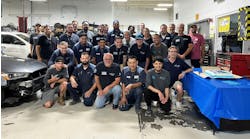But OSHA also found that the shop hadn't done the mandatory test fits and medical evaluations on every employee required to wear respirators – something that OSHA says is among the Top 10 violations found in shops.
Based on conversations with shop owners and OSHA and safety consultants around the country, here are 11 key things shops can do to reduce workplace injuries – and avoid OSHA violations and fines.
Step 1. Make sure every employee has adequate eye protection
Eye injuries are among the most common injuries in collision repair shops. Debris can fall out from under raised vehicles as technicians work underneath or can become airborne from the force of a grinder or drill. Even detailers are at risk from bits of glass or debris blown back when using air nozzles to blow out a vehicle interior – or when air conditioning or heating vents are used the first time after an accident. Under the hood, a blown battery or radiator cap or hose can pose serious eye damage.
Approved protective eyewear – appropriate for each type of work an employee performs – is cheap insurance. Make sure every employee has one (or more) pairs that fit, and that they understand that wearing them is not optional.
Step 2. Stock up on gloves
Hand injuries account for more lost work-days in the automotive repair industry than any other type of injury. As with eye protection, you increase the odds that the proper style of protective gloves are worn if you make them readily available.
Four types of gloves may be needed. Leather or flame-resistant cotton gloves should be used when welding or working around hot metal (engine or exhaust systems, for example). Anyone handling glass should have Kevlar-lined gloves. Rubber insulated "lineman's gloves," rated at 1,000 volts, should be worn when working around the electrical system of a hybrid vehicle. And nitrile gloves that are at least 4- or 5-mil thick will help protect workers from contact and skin absorption of chemicals in oil, antifreeze and solvents.
Step 3. Make sure you have adequate fire extinguishers
Many fire extinguishers are rated to handle only two or three of the four types of fires that could occur. Shops should have extinguishers rated for Class A (wood and paper), Class B and C (flammable fluids and electrical) and Class D (special agents, combustible metals).
The magnesium used in some vehicles – such as in the core support for some Ford F-150s – is both extremely flammable and almost impossible to extinguish; water sprayed on molten magnesium will produce an explosive hydrogen gas. That's why a Class D extinguisher is needed.
Make sure there's an extinguisher no more than 50 feet away from any point in the shop, that signage clearly indicates where they are, and that they are inspected monthly and are easily accessible (mounted between 36 and 60 inches off the floor).
Step 4. Make sure respirators fit properly and are being worn
Most shops work with their paint or respirator jobber to conduct basic respirator training and fit testing as OSHA requires. But many neglect to comply with another OSHA regulation: getting the necessary physical check-up and approval by a licensed healthcare provider for any employee whose work environment requires the use of a respirator. And it's still far too common for technicians with facial hair to use negative pressure respirators – which can make an adequate seal only on a clean-shaven face – rather than a positive pressure respirator.
Step 5. Tidy up your shop
Have spills cleaned up immediately. Trips, slips and falls often are caused by unnecessary items such as old parts or boxes that are left lying around the shop rather than being disposed of quickly and by spills or other causes of slick floors that also aren't addressed. Using hose reels and designating storage places for floor jacks, tools and other equipment when not in use can reduce tripping hazards. Maintain adequate supplies of absorbent towels and other materials – including "caution signs" – needed to handle spills.
Step 6. Conduct employee training on lifting technique
Most back injuries result from improper lifting. Give employees regular reminders about "good lifting" basics: plant both feet shoulder-width apart, squat down with your back straight and knees bent, grip load with both hands, stand slowly letting your legs do the lifting. Never twist while lifting or carrying a load. And use a similar process to unload, bending your knees, not your back.
Step 7. Check power tools regularly
Worn or frayed cords and plugs can easily lead to electrocution. Make sure employees know to report any tools in need of attention immediately. A power tool should not be carried by the cord, nor unplugged by yanking it from the outlet. Assign responsibility for regular maintenance on tools, and if any are found that should not be used, they should be clearly marked as such.
Step 8. Don't presume employees always will use "common sense"
Make sure grinders and other rotating equipment have guards in the specified positions because employees don't always think about the dangers of wearing clothing or jewelry that could get caught on such equipment. Make sure jacks are used only in vehicle locations specified by the automaker – and only with wheel blocks, jack stands or other secondary support. Make sure anyone driving a company or customer vehicle knows to walk around the vehicle to check for obstacles – or problems with the vehicle – before it is moved. It all sounds simple and logical, but these are common mistakes, particularly for younger workers, that can lead to injuries.
Step 9. Mark all secondary containers
This is one that frequently leads to OSHA violations as well as repair mistakes and worst of all, injuries. Many shop chemicals are bought in bulk, then poured into smaller containers for use. These secondary containers must be clearly labeled with the same product name and information found on the larger container.
Step 10. Make employees aware of the dangers of bloodborne pathogens
Even dried blood poses risks when it is moistened, such as during clean-up. Again, protective nitrile gloves (worn under heavier work gloves when necessary) and eye protection are critical. Have chlorine bleach and alcohol disinfectants on hand; these can be used on rags or paper towels to clean up droplets or spatter residue, and to clean eye or face protective gear after use. (Remember that bleach can damage or discolor some plastics and most cloth surfaces, so try it first in a small area that will not show, or use another disinfectant.) Disinfectant should be allowed to mix with any pooled spill for at least 20 minutes prior to clean up.
Step 11. Have your lifts inspected, and review lift safety
American National Standards for safety require that all lifts, other than screw drive systems, incorporate a mechanical device to prevent downward movement of more than six inches after stopping motion. This function must begin within 24 inches of rise, and continue to the full-rise position. The company you purchased the lift or other equipment from may be able to inspect your lift for compliance and any needed or recommended maintenance.
In terms of training, the Automotive Lift Institute offers a variety of manuals, signage and videos regarding safe use of lifts, as well as a regular update guide to model-specific vehicle lifting points. For more information, call the organization at (607) 756-7775 or check its Web site at www.autolift.org.
Because of the types of tools and work involved in collision repair, shops will never be able to completely eliminate workplace injuries or accidents. But these 11 steps will go a long way in addressing the most common sources of worker accidents and lost-time incidents.



